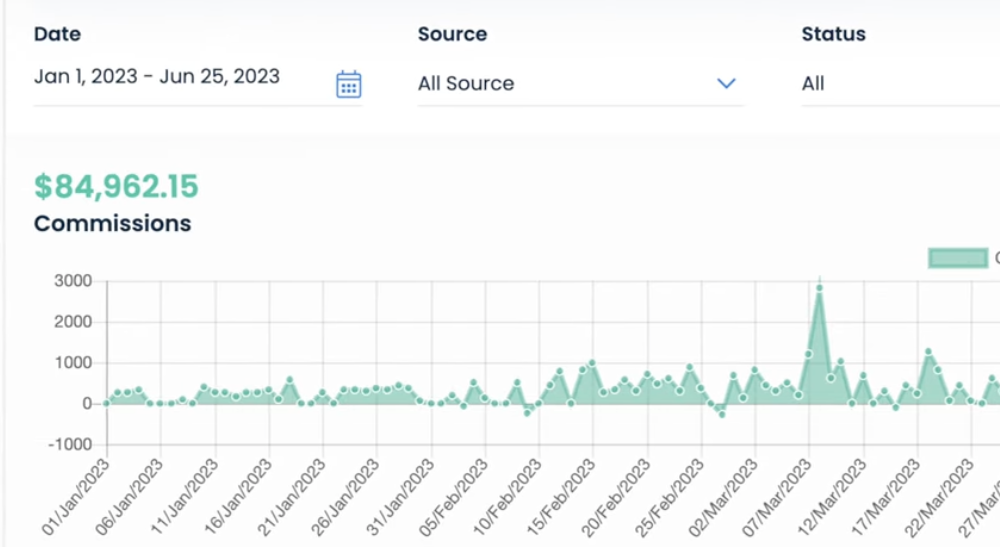Hey, it’s Sam Oh and welcome to the third lesson in our affiliate marketing course. In this lesson, I’ll give you a high-level overview of how to make money with affiliate marketing. When you join an affiliate program, you’re able to generate unique affiliate links. When someone clicks on one of your links and makes a purchase within a set period of time, you’re paid a commission. So, the more relevant traffic you get, the more clicks you’ll get on your affiliate links. And the more clicks you get, the more conversions, which equals more money in your pocket. There’s no limit to how much money you can make as an affiliate marketer. For example, Pat Flynn reported over $100,000 in affiliate commissions and Ryan Robinson reported over $19,000 in affiliate revenue. However, in order to make a sustainable income with affiliate marketing, you need to think of your affiliate site as a business. It will be a grind, but when you adopt a business mindset, you’re setting yourself up for success. So, let’s move on to the next lesson where I’ll give you a high-level overview of what it looks like to start and grow your first affiliate site.

This image is property of i.ytimg.com.
Lesson 1: Introduction to Affiliate Marketing
What is affiliate marketing?
Affiliate marketing is a business model where individuals or companies promote other people’s products and earn a commission for each sale made through their unique affiliate links. It is a performance-based marketing strategy that benefits both the affiliate marketer and the product owner.
How does affiliate marketing work?
In affiliate marketing, the affiliate marketer promotes products or services by placing their unique affiliate links in various channels like websites, blogs, social media platforms, or emails. When someone clicks on an affiliate link and makes a purchase within a specific time frame, the affiliate marketer earns a commission.
Benefits of affiliate marketing
There are several benefits of affiliate marketing. Firstly, it allows individuals to earn passive income by promoting products they genuinely believe in. Affiliate marketers have the opportunity to work from anywhere with an internet connection and have flexible working hours. Additionally, affiliate marketing provides a low-cost entry point for entrepreneurs who want to start their own online business.
Common terms in affiliate marketing
To better understand affiliate marketing, it’s important to familiarize yourself with some common terms. These include:
- Affiliate: The person or company promoting the product or service.
- Affiliate Program: The program created by the product owner to allow affiliates to promote their products and earn commissions.
- Affiliate Link: A unique link provided to the affiliate to track their sales and commissions.
- Conversion: When a customer completes a desired action, such as making a purchase, after clicking on the affiliate link.
- Commission: The percentage or fixed amount of money the affiliate earns for each sale or action.
- Cookie: A small piece of data that is stored on the user’s browser and helps track sales or actions. Cookies have an expiration date and determine which affiliate gets credit for a sale.
Lesson 2: Choosing the Right Affiliate Program
Researching affiliate programs
Before choosing an affiliate program, it’s essential to do thorough research. Look for programs that offer products or services in your niche, have a good reputation, and provide attractive commission rates. Read reviews and testimonials from other affiliate marketers to gain insights into their experiences with different programs.
Different types of affiliate programs
There are various types of affiliate programs to choose from, including:
- Pay-Per-Sale (PPS): Affiliates earn a commission for each sale they generate.
- Pay-Per-Lead (PPL): Affiliates earn a commission for each lead or sign-up they generate.
- Pay-Per-Click (PPC): Affiliates earn a commission for each click on their affiliate links, regardless of whether a sale is made.
- Two-Tier: Affiliates earn commissions not only for their own sales but also for sales made by other affiliates they refer to the program.
Finding profitable niches and products
To be successful in affiliate marketing, it’s crucial to choose profitable niches and products. Conduct market research to identify niches that have high demand and low competition. Look for products or services that have a unique selling proposition and offer value to your target audience.
Evaluating commission structures
When evaluating different affiliate programs, consider the commission structures offered. Look for programs that provide competitive commission rates that align with the effort and resources you plan to invest. Consider whether the program offers recurring commissions or has different commission tiers based on performance.
Lesson 3: Setting Up Your Affiliate Website
Choosing a domain name
When setting up your affiliate website, choosing the right domain name is important. The domain name should be relevant to your niche, easy to remember, and preferably include keywords that describe your content. Avoid using trademarked terms or misleading names that may confuse visitors.
Selecting a web hosting provider
A reliable web hosting provider is crucial for the performance and security of your affiliate website. Look for a hosting provider that offers good uptime, fast loading speeds, responsive customer support, and scalable hosting plans. Consider factors such as bandwidth, storage, and server location.
Setting up your website with WordPress
WordPress is a popular content management system that offers flexibility and simplicity for setting up and managing a website. Choose a WordPress theme that suits your niche and customize it to create a visually appealing and user-friendly website. Install essential plugins for security, SEO, and analytics.
Installing necessary plugins
Plugins enhance the functionality of your website and help optimize it for affiliate marketing. Consider installing plugins for SEO optimization, website security, caching, social sharing, affiliate link management, and analytics. Only install plugins from reputable sources and regularly update them to ensure compatibility and security.
Lesson 4: Creating High-Quality Content
Understanding the importance of content
Creating high-quality and valuable content is crucial for the success of your affiliate website. Quality content attracts and engages your target audience, establishes your credibility, and encourages conversions. Focus on creating content that solves problems, addresses the needs of your audience, and adds value to their lives.
Keyword research for affiliate marketing
Keyword research is an essential part of content creation for affiliate marketing. Identify keywords and phrases that have high search volume and low competition. Incorporate these keywords naturally into your content to improve search engine optimization (SEO) and increase organic traffic to your website.
Writing product reviews
Product reviews are an effective way to promote affiliate products. Write honest and detailed reviews that highlight the features, benefits, and drawbacks of the products you are promoting. Include personal experiences and provide valuable insights to help your audience make informed purchasing decisions.
Creating informative and engaging articles
In addition to product reviews, create informative and engaging articles that provide value to your audience. Write tutorials, guides, listicles, and informative blog posts related to your niche. Incorporate visuals such as images, infographics, and videos to enhance the user experience and make your content more shareable.
This image is property of images.unsplash.com.
Lesson 5: SEO Strategies for Affiliate Marketing
On-page SEO techniques
On-page SEO techniques involve optimizing your website’s content, structure, and HTML elements to improve its visibility in search engine results. Optimize your page titles, meta descriptions, headers, and URLs with relevant keywords. Use internal linking to improve navigation and user experience.
Optimizing your content for search engines
Create high-quality, original, and keyword-rich content that addresses the needs of your target audience. Use relevant keywords in your titles, headings, and throughout your content. Ensure your website is mobile-friendly, has fast loading speeds, and is easy to navigate. Optimize images with alt tags and compress them for faster loading times.
Building high-quality backlinks
Backlinks from reputable and relevant websites can significantly improve your website’s authority and search engine rankings. Focus on acquiring backlinks through guest blogging, collaborations, influencer partnerships, and content promotion. Ensure the backlinks you acquire are from trustworthy sources and follow proper link building practices.
Using social media for SEO
Social media platforms can play a significant role in boosting your website’s SEO. Share your content on social media channels to increase visibility and encourage engagement. Engage with your audience, build relationships with influencers in your niche, and encourage social sharing of your content. This can lead to more backlinks and increased organic traffic.
Lesson 6: Driving Targeted Traffic to Your Website
Paid advertising methods
Paid advertising methods such as pay-per-click (PPC) advertising can help drive targeted traffic to your website. Set up PPC campaigns on platforms like Google Ads, Facebook Ads, or LinkedIn Ads. Use keyword targeting, demographic targeting, and ad testing to improve campaign performance and maximize ROI.
Search engine marketing (SEM)
Search engine marketing involves optimizing your website and running paid search ads to increase visibility and drive targeted traffic. Conduct keyword research to identify valuable keywords for your niche and create compelling ad copies. Monitor and analyze the performance of your SEM campaigns regularly to make data-driven decisions and improve results.
Social media marketing
Leverage the power of social media platforms to drive targeted traffic to your affiliate website. Create engaging and shareable content, build a strong presence on platforms relevant to your niche, and interact with your audience. Run targeted social media ads to reach a wider audience and drive traffic to your website.
Email marketing strategies
Build an email list of interested subscribers to nurture and convert them into customers. Send regular newsletters, updates, and promotional emails to your subscribers, providing them with valuable content and offers. Personalize your emails, segment your audience, and track email performance to optimize your email marketing campaigns.

This image is property of images.unsplash.com.
Lesson 7: Conversion Optimization Techniques
Understanding conversion rate optimization
Conversion rate optimization (CRO) involves improving the percentage of website visitors who take a desired action, such as making a purchase or signing up for a newsletter. Analyze user behavior, conduct A/B testing, optimize website design and navigation, and simplify the conversion process to improve conversions and maximize revenue.
Designing compelling landing pages
Create visually appealing and user-friendly landing pages that drive visitors to convert. Use persuasive headlines, clear calls to action, and compelling visuals to grab the attention of your audience. Optimize landing pages for fast loading speeds, mobile-friendliness, and easy navigation to improve user experience.
A/B testing for better conversions
A/B testing involves comparing two versions of a webpage or element to determine which one performs better in terms of conversions. Test different elements such as headlines, colors, layouts, and call-to-action buttons to identify the most effective variations. Continuously monitor and optimize your website based on the results of A/B tests.
Call-to-action strategies
Effective call-to-action (CTA) strategies can significantly improve your conversion rates. Use clear, action-oriented language in your CTAs, such as “Buy now,” “Sign up today,” or “Download free ebook.” Experiment with different placement, design, and wording of CTAs to find the most compelling options for your audience.
Lesson 8: Analyzing and Tracking Affiliate Marketing Performance
Setting up Google Analytics
Google Analytics is a powerful tool that allows you to track and analyze various metrics related to your website’s performance. Set up Google Analytics by adding the tracking code to your website. Use it to monitor traffic sources, user behavior, conversion rates, and other key metrics to make informed decisions and optimize your affiliate marketing efforts.
Tracking affiliate links and conversions
To track the performance of your affiliate links, use affiliate tracking software or plugins provided by the affiliate program. These tools allow you to monitor clicks, conversions, and commission earnings associated with each link. Regularly review your tracking data to identify top-performing links, optimize low-performing ones, and make data-driven decisions.
Analyzing key metrics
Analyze key metrics such as click-through rates, conversion rates, average order value, and revenue per visitor to evaluate the effectiveness of your affiliate marketing efforts. Identify trends, patterns, and areas for improvement. Continuously test, track, and analyze your data to optimize your strategies and maximize your affiliate earnings.
Making data-driven decisions
Base your decisions on data and insights gathered from tracking and analytics tools. Use the information to identify strengths, weaknesses, and opportunities for improvement. Experiment with different strategies, content formats, and promotional tactics based on the data you gather. This will help you refine your approach and achieve better results in your affiliate marketing efforts.
This image is property of images.unsplash.com.
Conclusion
Affiliate marketing offers a lucrative opportunity to make money online by promoting products and earning commissions. With the right strategies, dedication, and continuous learning, you can build a successful affiliate business. Remember to choose the right affiliate programs, create high-quality content, optimize your website for SEO, drive targeted traffic, and track and analyze your performance. By treating your affiliate site as a business and adopting a data-driven approach, you can increase your chances of making a sustainable income and achieving success in the world of affiliate marketing.






